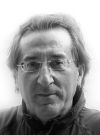Fundamental Movement Skills and
Their Application to Sports Initiation
Francisco Seirul·lo Vargas
Profesor in the Instituto Nacional de Educación Física de
Barcelona
University of Barcelona
Document of the INEFC de Barcelona; Seirul·lo Vargas, F.
(2004-2005)
INTRODUCTION
Normally, the initiation to sports is done by means of
models constructed for professionals, and the exercise
programs are proposed according to those which are suitable
to achieve professional goals in stages supposedly common
for all athletes. The same people who develop these
models are the same people who indiscriminately apply the
selection tests and prematurely detect talents. All of
which, in many cases, results in the abandonment of the game
or sport by failing to obtain results. The professionals in
question use the excuse of an athlete being not good enough,
but in truth, many times the failure of the young athlete
lies in a mismanagement of training processes that are built
backwards from the true needs of the athlete.
The alternative we propose centers on the athlete, in the
needs of the individual at a specific time in life, so the
proposed tasks are situations only subject to the
requirements for competitive sport created in the individual
practice; they are formulated with the understanding of the
individual as being unique, open, and in continuous
interaction with the surrounding environment.
Therefore, the contents of each phase will be built
depending on the specific age category and the challenges it
poses, with each subject solving these challenges according
to their very own talents and dedication. This is the way to
find and capture the true talents of the individual.
This proposal is constructed as a model that must be
adjusted to the actual situation of each athlete or group of
athletes. The core idea behind initiation to the
practice of sport promotes obtaining the desired results in
the later ages, without a premature rush to early and
immediate results, which can only be a consequence of well
developed personal talents, and never the purpose of these
initial phases.
Every athlete must create a personal project relative to
their life in sports, adjusting the project to their needs
and potential. This is the only option if you want
optimal results in the key times of an athlete’s life. At
this point will his personal talent and luck define the
exact nature of the process and how it should be adapted to
the athlete.
THE PROJECT
The criteria to designate each stage and their phases are
taken from models proposed in the former DDR (Deutsche
Demokratische Republik) and completed by recent studies
proposed in initiation schools in France and Italy.
Based on these criteria we have planned the content of
training for young people in F. C. Barcelona during the last
15 years.
The basic thrust of the early stages is primarily
physiological, but also contemplated in conjunction with
psychosocial aspects, especially in the justification of
methodologies and conditions for implementing the tasks.
In stage A of the initiation, phases are demarcated every
two years, as in these early ages the physiological and
psychosocial processes evolve rapidly and significantly.
While in stage B, the phases are 4 years, adjusted to
Olympic cycles which could possibly be a priority objective
of the high-performance stage, and in some of these
specialties bienniums can be made to adjust to world
championship cycles. The construction of a proposed life in
sports is subject to processes of maturation and
development, and the age categories we demarcate and suggest
are only approximations, but in any case, these groupings
apply to a majority of individuals.
In the ages of stage C the proposals are even more
approximate. It depends on which sport, and it should be
noted that for men this approximation is closer than for
women. In all cases this proposal should be understood as an
interpretive model to be understood as a point of reference,
which each individual must change according to their goals
and interests.
The project is divided into three stages:
A. Introduction to practice
B. Obtaining high performance
C. Decreasing functionality
Each of the 3 major stages happens over the course of 10-12
year periods, and is further subdivided in phases:
A1. Non-specific Movement Practice Phase (ages 5-7)
A2. Generic Polyvalent Devlopment Phase (ages 8-10)
A3. Multilateral Oriented Preparation Phase (ages 11-13)
A4. Specific Initiation Phase (ages 14-16)
B1. Specialization Phase (ages 17-19)
B2. Perfecting Phase (ages 20-23)
B3. Stability and High Performance Phase (ages 24-28)
C1. Mantaining High Performance Phase (ages 29-34)
C2. Compensatory Adaptation to Reduced Performance Phase
(ages 33-38)
C3. Functional rehabilitation for non-competitive
performance (ages 30-41)
It is imperative that every athlete is oriented over the
course of an athletic life for a project that prevents very
common mistakes when competition is rushed and the
temporality of the main criteria – the optimization of the
individual – is not respected.
A1 REGULAR AND NONSPECIFIC PRACTICE:
5 TO 7 YEARS OLD
This is a regular practice added to the physical education
activities the child performs in school. It includes at
least two sessions more per week in addition to the school’s
physical education.
The intention is to be entirely focused in the integral
education of the subject's motor skills. It is not yet known
what the student athlete will or wants to be, and that
should mean a practice of development sufficient to get a
thoroughly developed optimization of all motor skills.
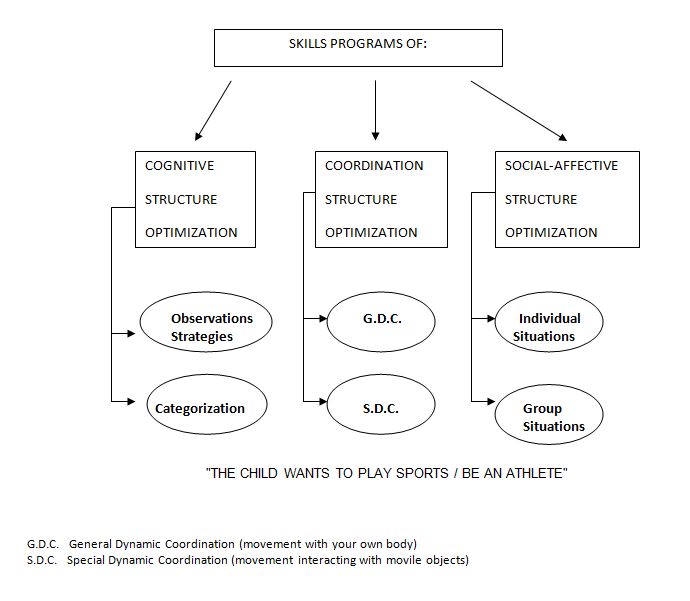
TASK CONDITIONS
We must build tasks in which the activity centers on
elements of the cognitive structure, or coordination
structure, or socio-affective structure, but tasks
sufficient to ensure acquisition within the range of the
proposed target.
The tasks should be presented cyclically and with almost the
same conditions to confirm their assimilation overtime and
in similar situations.
Quantitatively, situations privileging the coordinative and
cognitive capacities should be given priority over the
socio-affective. But all must have a high level of quality
clearly adjusted to the level of the student.
PLANNING
We must know the PE program of schools to complete the
contents if they are not targeted.
If possible, use the same terms to describe the situations
to avoid creating confusion.
Ideally, this practice is every other day and respects the
school holidays as comprehensive vacation.
A2 VERSATILE AND GENERIC TRAINING:
8 TO 10 YEARS OLD
Continue the process of generic development to achieve the
largest possible foundation of motor skills. A foundation
capable of solving the prerequisite motor skill demands of
any sport.
We must reaffirm the habituation and integration of the
athlete's generic motor skills.
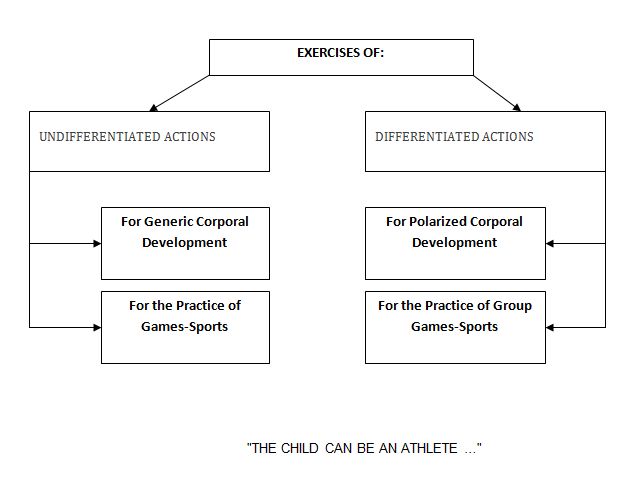
GENERAL ASPECTS OF A2 PHASE
At this point, we focus on making a versatile athlete; we
open all possible paths of different motor options for the
athlete, this way we avoid losing future potentialities.
Thus, through the continuing Exercise of Undifferentiated
Action we have further confirmation of their basic motor
skills, as the practice of the previous phase is
insufficient to resolve the targeted levels of competency in
all areas of their motor skills to be displayed in this
moment.
Practice time should increase to at least three sessions per
week, in addition to the school practice. These
practice sessions may be simultaneous with a day of
competitions, but always characterized by focusing on
developmental goals and multiple sports. The sport can be an
individual or a collective, but the practice should be done
without specializing in positions or specific activities; if
they can do more, all the better.
It is desirable to enhance adherence from practices, doing
the Exercises of Differentiated Action, in those areas where
the subject shows an increased level of competency. Although
still within healthy ranges and without closed cycles of
large numbers of homogeneous repetitions, promoting the full
capabilities latent in the subject, which will give
personality and individuality to the motor skills and
constitute the pillars of subsequent personal performance.
Exercises are defined as being in either the category of
Undifferentiated Actions, or Differentiated Actions:
All those here are of an overall generic character, but as
the Undifferentiated Actions completely maintain this
generic character, the Differentiated Actions have some
approximation to certain criteria. That is to say, they
(Differentiated Actions) are attracted towards concrete
elements (polarized), be they morphological, mechanical, or
an interaction of the two. In this way the generic
requirements of the personalization process can be solved,
and the particular needs of the individual begin to become
apparent with the differentiated practice. Each athlete is
unique, but it is still necessary to build their generic
development and using these types of generic exercises
should provide the solution to these needs.
FOR GENERIC CORPORAL DEVELOPMENT
Optimize the knowledge and the realization of one's body
with attention to:
●
Balanced and generic development of musculature
●
Maintenance of joint mobility
●
Developing the basic coordination skills
●
Familiarization with the basic conduct of self-observation
●
Development of Theoretical-Basics
Respecting
absolutely the player's integral maturation, we cooperate
with him, promoting these aspects to the athlete’s own level
of motivational achievement is sufficient, and executing
with efficiency the proposed situations in practices
oriented toward their continuing and varied stimulation,
which will allow for identification with his own motor skill
efficiency through familiarization with the practice of
self-observation.
FOR POLARIZED CORPORAL DEVELOPMENT
Optimizing knowledge and the level of realization of the
one's body with attention to:
●
Training differentiated toward the incipient muscular
deficiencies discovered
●
Development of Coordinative Capacities in which the player
shows more competence; especially aspects of re-Balance and
Motor Control
●
Familiarization with self-control behaviors
●
Developing Theoretical Basics
Thanks to the differentiated training exercises, we discover
the talents and deficiencies that the subject has when faced
with practical situations. He also participates in these
discoveries, and through their own self-control should aim
to increase efficiency in the implementation of each
practice.
As we see, there is not an early specialization, but
practical differentiation in elements necessary for the
optimization of the complete student. Therefore, the large
variation in games-sports proposed that allow us to observe
in depth all the deficiencies and strengths of his
competitive personality. The young athlete must recognize
these things because it is the first phase of willingness to
voluntarily modify and engage in a higher level of
achievement.
FOR THE PRACTICE OF GAMES-SPORTS
_
It is practiced in the form of the different sports that
involve the diversity of all the player’s motor skills.Thus
the athlete must adjust his motor skills to the varied
regulations of different sports which obviously can be
modified - in part to obtain clearer particular
objectives.
_ Utilizing a constellation of 2-3 individual sports
and 4-5 team sports in order to comprehensively engage all
of the player's motor skills.
_ It is not competing in these sports, it is playing the
variety of sports, even mixing rules of one with the
other, to attain the desired stimuli:
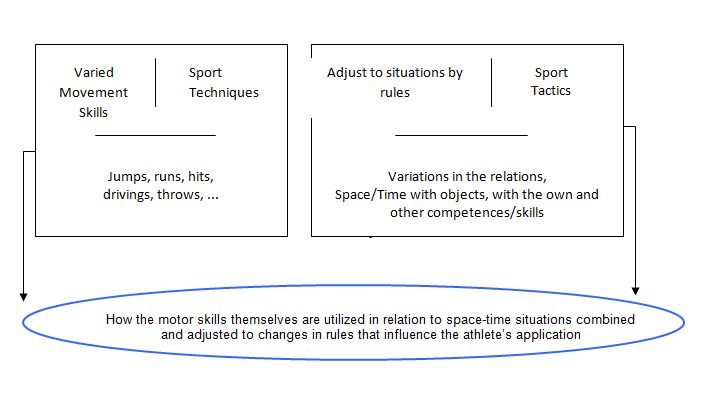
FOR THE PRACTICE OF GROUP GAMES-SPORTS
_ Now appears the need to practice to develop the play of
group sports that comprise a certain sector of the subject’s
capacities in which the subject appears to have some
facility of realization, i.e. natural tendencies.
_ The sports practiced are thought of as possibilities for
the future, but with changes and variability to avoid
premature specialization.
_ There is here an emerging priority to achieve the
cognitive foundations of the group sports that in the future
could be his specialty.
_ Simultaneous with the cognitive priority is the need to
develop situations of interaction varied by their
participation in different games that allow continuity in
the optimization of the socio-affective that was begun in
the previous stage, but which are shaped by proposals
tailored to the needs of the player, according to feedback
discovered in the varied experiences thus lived.
_ The player himself must, based on their auto -control
practices, be able to define their own needs and they can be
communicated with an appropriate terminology for acquiring
and developing his theoretical fundamentals.
PROPOSAL FOR THE CONSTRUCTION OF TASKS
The Movement Block
They are more or less complex units of information as sets
of integrated possibilities for implementing certain
materials pertaining to technical and tactical groups of
sports with which they share certain affinities. The
conditions of their practice must be accomplished so as to
become a vast storehouse of resources without closing off
alternatives the athlete can access. So you can preselect
tasks more compatible with the specific situation that
presents itself.
There should be a wealth of techniques and tactics, but it
must be a "Configuration" in agreement with the variability
of those appearing in certain sports with selected
affinities. This configuration is the responsibility of the
coach.
The selection of these sports is determined by the degree of
familiarity the coach has of the motor skills involved in
their implementation. Because this way they may get more or
less compatibility between components. The quality of these
selections are essential to configure the core block and get
the optimization of the practitioner.
Knowledge of the motor skills involved should be grown from
the perspectives of coordinative, cognitive and
socio-affective capacities, which are the categories that
comprise the preferred targets for the optimization of the
individual at this stage of initiation.
Their practice is crucial for locating talent in the sports
and in these ages they become manifest, helping us in
directing talent specialization in the athlete’s later
stages to follow.
A3 PREPARATION OF MULTILATERAL
ORIENTATION: 11 TO 13 YEARS OLD
_
In a progressive manner create a practice oriented toward
the sports,
and
then to the sport, in which the greatest efficacy is shown.
EXPERIMENTATION AIMED TO ACHIEVE THE SKILLS AVAILABLE WITHIN
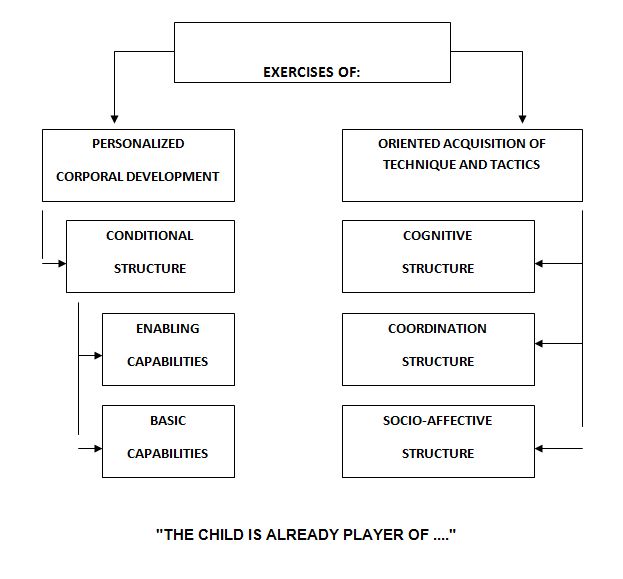
GENERAL ASPECTS OF A3 PHASE
_ This phase is key to the project of athletic life, as this
is when the emergence of the predominant conditional
capacities associated with the process of physical growth
begin to appear, and if we do not maintain the balance of
these processes with those of technical-tactical learning,
the player’s auto configuration will always be problematic.
_ It is in this phase when we define the validity of a
particular player for a particular sport, though we had
already suspected his potential in the previous phase, and
this is the time of his configuration.
_ We offer technical and tactical tasks for the game and
these are foundations of the subsequent performance of
specific practice in the higher levels of this
specialization. These tasks have all been the prerequisites
of the coordinative and cognitive practices of the phase
above.
_ We must propose the largest possible number of technical
and tactical sessions where there are different forms of
practice to maintain motivation.
_ The number of workouts is increased to a minimum of four
sessions in addition to the competition, which will be
played in different positions and under different systems of
the game.
PERSONALIZATION OF PHYSICAL DEVELOPMENT
_ We must accomplish, while respecting the evolution of
personal maturity, development of the athlete’s conditional
structure.
_ This structure must support the technical and tactical
acquisitions that are basic to their sport specialization,
but always "subject" to the needs of the individual. The
technique must be learned and practiced at full speed of
implementation, therefore Basic Conditional Capacity must be
cared for in a special way such that it gives the player
adequate strength to be able to move fast and so the
technique should be practiced under those parameters.
_ Only in those moments can be justified biopsy samples to
determine % types of fibers if this is not clear by other
procedures.
_ To maintain multilateral functionality in this phase of
technical and tactical acquisitions, we focus the
optimization of conditional structure in the basic skills to
avoid fundamental weaknesses that are crucial in the
auto-configuration process.
_ Maintenance of facilitating capabilities is essential to
achieve the targets indicated above.
ACQUISITION TARGETED TO THE TECHNICAL AND TACTICAL
_ The concept should be oriented to the observation of the
process from the perspective of player, because the
technique and tactics will become their technique and
tactics, so that the proposals should be guided by the level
of resolve this particular player has for acquisition.
_ We must therefore suggest tasks tailored to personal
potential, and this, in a group practice, is feasible if we
propose a variety of situations in a context for
understanding, and without a large number of repetitions.
_ To facilitate these processes, should not do throughout
this phase any other sport, although training of unique
situations, cognitive situations and socio-affective
situations typical of other specialties can be introduced
into this practice.
_ Maintaining as much as possible the "prospective
potential" of techniques available should govern all the
achievements and the coach should stimulate this with
information and a variety of proposals.
_ Both the trainer and the player must focus on valuing the
execution of the actions, and not the result. The major
motivation of the player must be doing well, and afterwards
associate their efforts with the consequences, with the
results of his performance.
A4 INITIATION OF THE SPECIALIZATION:
14 TO 16 YEARS OLD
_ It leads the athlete within their chosen sport to the
acquisition of global tactics and techniques, and then
further towards specialization in a specific position which
can claimed for their own based on their personal
capabilities.
_ Arrival and adaptation to the specific sport suited best
to the athlete's personal ability.
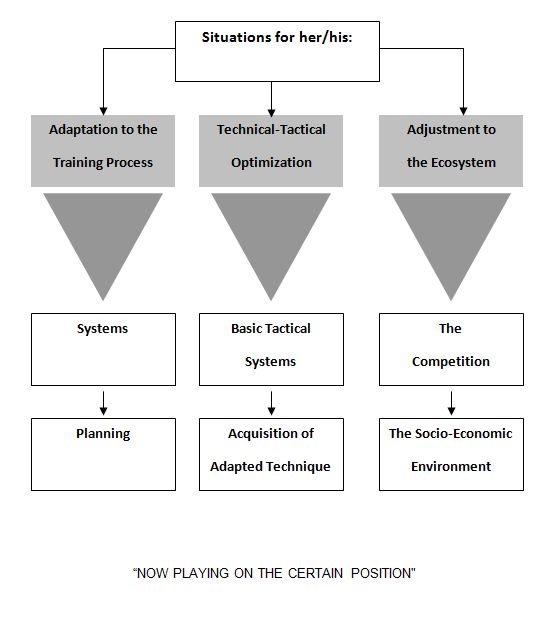
GENERAL ASPECTS OF A4 PHASE
_ In
the last phase the player has a certain personal level in all the techniques and
tactics of the sport they have chosen. At this point the player enters into the
initiation of his specialization. Specifically, to acquire the initial elements
that are unique to a particular demarcation, confidently knowing the groundwork
has been laid, having realized everything in the process for this achievement.
_
This is the time where the coach can make a projection on the future of the
player. If, after this phase, the player does not confirm his talent, then he
should withdraw from highly competitive environments in that specialty.
_
The player now enters the game as a part of the collective group based on his
personal capabilities, and in this context must start the acquisition of all
appropriate values and details of the sport and of the competition in which he
has chosen to specialize.
_
The morphological development weighs heavily on determining certain positions
within the team. So if a player has confirmed his defensive skills versus the
offensive the possible morphological changes that occur in these years will have
time to finaly define a specific position in the defensive line; the issue of
specific positioning should clearly clarified at the end of this phase.
ADAPTATION TO THE TRAINING PROCESS
_ It
must have sessions with a focus on the conditional capacities. The systems will
be used to enhance the skills the player needs to resolve situations within
their area. The preparation is still prioritize the needs of the game compared
to the competition and result.
_
Planning should respect the configuration of the player with programs tailored
to their needs from the most general at the beginning of the week and cycles, to
the most specific at the end of the week and cycles.
_
Now five days of training and competition are proposed, with one day of rest
weekly. As at least one and a half month break between seasons.
_
Planning of simulated preferential situation with adapted difficulty and with
alternatives if needed to give rest to the systems involved.
TECHNICAL-TACTICAL OPTIMIZATION
_ So
far we have focused on technical and tactical processes of the individual. From
this point the individual is prepared to assume a role within a group so you
have to solve the tactical compromises inherent in the collective, as well as
acquire the technical capacities required for the position they occupy within
the team and the successful fulfillment of the tasks that comprise their role.
_
The speed and variety of performances are put to the service of the team and
with any commitment that the team makes during the year to participate in
competitions.
_
Individual technique adapted to the position, but it should not be raised to the
level of absolutes until you have experienced and proven its validity in all
situations that provide a certain basic tactical system flowing from the game of
the actual team.
_
Nearly all the technical achievements should be proposed in relation to
associated tactics for the player to self-assess their performance in consonance
with the valid tactic for which it was executed. This also confirms the validity
of his talent because a fundamental concern in in this phase is his commitment
to the team concept.
ADAPTING TO ECOSYSTEMS
_ To
confirm the level of talent of a player in this phase we also have the knowledge
of how the athlete adapts to the ecological conditions in which the sport they
practice operates.
_
The way they face the competition, how to assume their role in the team during
the game, on what ways will they affect the outcome, how to accept criticism and
praise, and everything that surrounds the competitive world, define other
elements of personality of the player. We need to make training sessions that
partly simulate these conditions, but the competition itself, which must also be
used as a route of optimization, using techniques of self-evaluation and
reflection.
_ On
the other hand, the culture that develops
around
the
sport, has an important role in defining image of the player. The team
environment, their assessment within the club, the social meaning in the city
and the economy, and the media, nuance many aspects of the player's personality.
In fact, these often have a greater impact than their own technical and tactical
training. In this phase, we must discern the basis of their suitability to the
ecosystem
for this not to
interfere in the project of progress toward high performance.
Technical English Translation by
Tod
Herskovitz · USA
www.CopyFreedom.com
|





